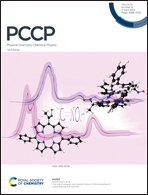Dyes for guest–host liquid crystal applications: a general approach to the rapid computational assessment of useful molecular designs†
Abstract
A set of experimental dichroic order parameters ranging from ca. +0.66 to −0.22 was obtained by recording polarized UV-visible absorption spectra from aligned samples of fifteen different guest anthraquinone and azo dyes in the nematic host 4-cyano-4′-pentylbiphenyl (5CB). DFT-optimised structures were calculated for between 1 and 16 conformers/tautomers of each dye, and their relative energies, UV-visible absorption wavelengths, oscillator strengths, transition dipole moments, molecular surface tensors and quadrupole tensors were obtained and used in subsequent calculations. A simple approach provided calculated UV-visible absorption spectra of the dyes that gave a qualitative match with the experimental spectra, and the calculated peak positions showed a linear correlation with the experimental values across the full visible range of ca. 350–700 nm. A short-range, shape-based, mean-field orienting potential based on the calculated surface tensors was combined with the calculated transition dipole moment vectors to give calculated dichroic ratios of the dyes that showed a linear correlation across the full range of experimental values. A modification of this mean-field orienting potential to include a long-range, electrostatic component based on the calculated quadrupole tensors gave a slightly improved linear correlation but a slightly worse overall match to the experimental values. The results show that short-range, shape-based interactions dominate the orienting potential for the systems studied here, with the inclusion of long-range quadrupole interactions providing a slightly better model for only some of the dyes. Overall, the use of a mean-field approach allied with molecular properties that can be calculated with relative ease and low computational expense has provided calculated peak positions and dichroic ratios that show good matches and correlations with experimental data from a variety of dye structures without the need to input any experimental data from the dyes. Hence, this method may provide a general and rapid approach to predicting the optical properties of dyes in liquid crystal hosts, enabling candidate dye structures to be screened prior to synthesis.

- This article is part of the themed collection: 2023 PCCP HOT Articles


 Please wait while we load your content...
Please wait while we load your content...